The gun dog that hunts with a French accent
By Jerry Thoms
Jipsie, a five-year-old orange and white French Brittany, leaps from the dog trailer and hits the ground in four-wheel drive with her engine roaring. She immediately dives into the chin-high South Dakota prairie grass--and disappears.
Bruce Mooney, Jipsie's owner, yells Jipsie's name and blasts on his whistle. But this dog, for the time, is gone in 240 acres of tall, dense bluestem with a thick understory of alfalfa.
A little more than 100 yards away, a surprised hen pheasant flushes--as if bumped up by a rambunctious 35-pound bundle of released energy that any dog might be after a four-hour trip from central Minnesota to east-central South Dakota. "Well, so much for my claims about French Brittanys being close-working, cooperative gun dogs dedicated to pleasing their owners," Mooney says as he calls Jipsie's name and blows his whistle one more time.
"She has gun dog writer's syndrome," I tell Mooney. "I see this all the time when someone wants to showcase a gun dog in an actual hunting situation. . .give her another minute and she'll be back here," I suggest.
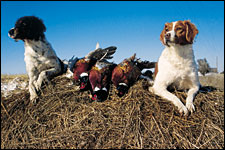 French Brittanys, bred for over 100 years in France and several other European countries, have been genetically designed as versatile gun dogs that will find, point, and retrieve all types of gamebirds. |
Sure enough, in 30 seconds Jipsie's back, panting hard with her tongue hanging--but looking straight into Mooney's eyes with a "That's out of my system; now let's go hunting" expression. Walking into the prairie grass, we meet up with Ivee; another French Brittany trained and handled by John Mooney, Bruce's brother. Ivee is a tri-colored nine-year-old whose parents were born in France, bought there in person by the Mooney brothers, and brought to their L'Escarbot Kennels in Hampton, Minnesota. There, Ivee was born and raised to become a main force in the Mooney's French Brittany breeding program. In addition, she has become one of their main hunting dogs for pheasant, ruffed grouse, prairie grouse, quail and partridge.
Ivee has another major distinction: She is the first French Brittany to be born in the United States then entered in a major "Shoot to Retrieve" competition in France. Hunted and handled by Bruce Mooney, Ivee placed second in the contest that featured more than 100 of the best French Brittanys in Europe. Now, however, she was hunting South Dakota pheasants.
"In France, the French Brittany has been bred for over 100 years as a gun dog genetically programmed to hunt every kind of upland gamebird in the field or woods, as well as ducks and geese on land and in water," Bruce Mooney had assured me in a phone conversation last August. "And, though we hunt all species of gamebirds with our Brits, our overall favorite is pheasant," he added.
"So, let's have a 'mini hunt test'," I told Mooney then. "Bring your dogs to South Dakota and we'll look for wild ringneck roosters in some big tracts of Conservation Reserve Program land I have permission to use."
Consequently, on this day in late October and with camera in hand, I follow the Mooneys and two of their French Brits through a jungle of shoulder high prairie grass interspersed with cattail sloughs and patches of 10-foot phrangnites. The first quarter-mile of our walk, however, is birdless.
"Point," Bruce Mooney finally hollers and I quickstep my way to where Jipsie is dead still and staring into the cover. Bruce motions for John to bring in Ivee, who backs Jipsie the second she sees her. A hen pheasant (of course) flushes while both dogs stay steady to wing, then take off again as soon as they're released from their pointing postures. "So far, so good," I'm thinking. "These dogs can find birds, point them, and don't chase them across the field when they fly."
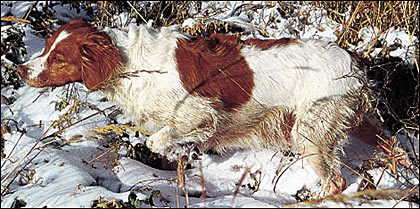 A solid and reliable pointing instinct is one of the major traits of the French Brittany. |
A few minutes later and a few hundred yards into a quarter-mile strip of standing corn filled with year-old stalks and tall pigeon grass, both Brits are again on solid points with one backing the other. This time six hens erupt all around the dogs and again they hold their positions.
Then a single rooster finally flushes, takes a flight path, wings 25 yards and finally crumples to the boom of Bruce Mooney's 12-gauge. Both Brits race to the bird. Ivee scoops it up, and holding it high in the grass, marches over to Bruce where she drops it in his hand. "Any concerns about these 'little' dogs retrieving 'big' rooster pheasants are pretty much over," I remember thinking.
"Keep on hunting. I'm out of film and need to get more from my truck," I tell the Mooney brothers. Halfway back to the vehicle and from up on top of a small hill, I watch the Mooneys as their two Brits neatly quarter in front of them. A few whistle blasts and some verbal commands keep the two dogs on course as they sort of porpoise through the dense vegetation.
Then the two Brittanys disappear. The Mooneys both move in to where the dogs must be pointing. A rooster flies up and a shot is fired. Then another. And another. The third round clips a bird wing and the rooster flutters down with its head up and its legs already in motion.
From the hilltop, I watch the dogs bound across and through the prairie grass then disappear again into the thick vegetation. A minute or so goes by. Then five minutes, then 10 more as the Mooney brothers follow their dogs, obviously on the trail of a fast-moving wounded ringneck.
One of the Mooneys finally stops and reaches down into the grass, takes the rooster from one of the dogs, then stuffs the bird in his game vest. Elapsed time: nearly 20 minutes.
"A pretty good hunt test for a couple of gun dogs," I say to myself as I reload my camera for some "grip and grin" photos a few hours and four roosters later. Quartering in the field, pointing a couple dozen pheasants, steadiness to wing, responsive to whoa commands and hand signals, solid retrieving, good tracking skills, and all demonstrated in heavy cover where wild pheasants can easily hide or run forever--yes, a very complete package.
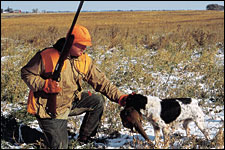 "Are French Brittanys big enough to hunt pheasants in heavy cover and to retrieve full-size roosters from thick vegetation?" John Mooney is sometimes asked this question by prospective buyers. "Let me show you," is his answer. |
A SHORT HISTORY OF THE FRENCH BRITTANY
"According to legend in France, and eventually several other European countries more than a century ago, the French Brittany was originally developed by working class hunters who wanted a dog that could be used to poach small game on the estates of upper class aristocracy," John Mooney says.
"These poachers wanted a small and very close-working dog that could slip in and out of the aristocrats' estates where gamebirds could be efficiently found, pointed, then netted. The birds would be caught and bagged and the hunters and their Brittanys would head for home," says Mooney.
"A small but powerful and efficient hunting dog with natural pointing instinct and a high degree of cooperation was what came from these early breeding objectives. As time went on, European breeders further developed these traits into the dogs we know today as the French Brittany."
THE FRENCH BRITTANY Vs. THE AMERICAN BRITTANY
"Several decades ago, the French Brittany was brought to this country where the breed was "Americanized" to create the orange and white, longer-legged, big-running, field-trial-type dog known today as the American Brittany," says Bruce Mooney. "As kids growing up in Minnesota, my brother and I had and hunted with this line of gun dog. And, though we loved our American Brits, we were often frustrated by their tendencies to be naturally wide ranging. Many times they would have no contact with us when hunting ruffed grouse in the Northwood's brambles of Minnesota or the cattail sloughs of South Dakota," Mooney recalls.
"Ten years ago we discovered French Brittanys, saw them as gun dogs more inclined to hunt up close and to be more cooperative. The more we hunted with the French version of the Brittanys, the more we liked them. And well, the rest is history. We now have a dozen of these dogs in our kennel where we breed and train them for the 'on-foot' gamebird hunter," Mooney says.
BREEDING FRENCH BRITTANYS
"If you want the best source for 'real' French Brittanys, you need to go to France to find the genuine article," Bruce Mooney believes. "That is, the Brittanys that have been diligently bred for many years to fulfill the requirements of time honored and stringent breed standards. These original French Brittanys have been carefully developed for three main qualities.
"First and foremost, the true French Brittany must be an exceptional hunter with a high degree of prey drive, natural pointing ability, instinctive retrieving skill, and an inborn tendency to quarter in the field close to the shotgunners," Mooney states. "All these traits have been created by hundreds of breeders with thousands of dogs from which to choose in breeding programs that have been in continual existence for decades. . .most all the top-rated French Brittany breeders run their dogs in organized testing events in which the dogs are judged and scored for their hunting instincts and performance," Mooney emphasizes.
"Second, and not any less significant, the French Brittanys in France and other European countries are bred for temperament with lots of emphasis on calm dispositions, good cooperation, and a real willingness to please. Headstrong and overly aggressive dogs are not tolerated no matter what positive qualities they may otherwise have," Mooney says.
"French Brittanys are born to be laid-back in the yard and in the home but can quickly switch over to dynamos when hunting gamebirds. . .'angels in the house, demons in the field' is a common phrase applied to French Brittanys in France--and in this country," Mooney claims.
"A third major objective among French Brittany breeders in France is conformation. The goal is to produce dogs that have a 'cobby' structure. This means a 'square' physical profile in which the dog is as long from the front of its chest to the tip of its butt as it is high from it feet to the top of its back," Mooney explains.
"This 'cobby' quality creates dogs with a short but powerful gait or stride developed for hunting in heavy cover up close to the gunner. A truly cobby Brittany is one in which form and function come together to produce a dog well suited for the on-foot hunter who wants to walk up pheasants, ruffed grouse, woodcock and quail.
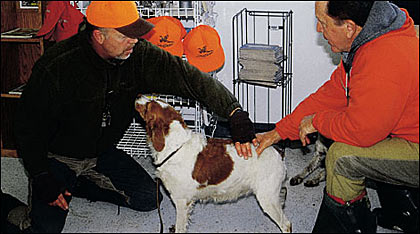 "French Brits have what is called a 'cobby' or square conformation so that, in profile, they are as long from the front of the chest to the tip of the butt as they are high from bottom of the feet to the top of the torso," Bruce Mooney (left) points out to the author. "This 'form' is related to 'function' because this 'cobby' structural design naturally creates a powerful short-range and up-close running style well suited to hunting in thick grass when gunning for pheasants in prairie grass or when searching in snarly brambles for Northwoods ruffed grouse," Mooney says. |
"Unlike many field trial bred bird dogs in America, French Brittanys don't require a horse for a hunter to follow and keep up with them," Mooney says. "Nor do you need to tie log chains on these dogs or strap on electric collars to keep most French Brittanys in bird-killing shotgun range."
TRAINING FRENCH BRITTANYS
"French Brittanys are bred and genetically programmed to be close working, natural-quartering, instinctive-retrieving, and owner-pleasing pointing dogs. But all these traits, as with any breed of gun dog, have to be shaped and developed through training," John Mooney notes.
"If you don't use a check cord to establish the preferred distance for quartering, some of these dogs may choose a hunting range way beyond a hunter's preference," Mooney points out. "Likewise, if you don't do your yard work on basic obedience or retrieving, most French Brits will make their own decisions on how to do these things," Mooney adds.
"The natural hunting instincts are definitely inherent in French Brittanys, but the trainer must be prepared to give them a final form," Mooney advises. "As a training program for our dogs, we suggest the usual course of yard work to include lessons on heel, come, and whoa. Out in the field, we introduce our dogs to birds beginning with pigeons and released quail. Later we move on to pheasants. We also follow the usual procedures for breaking young dogs to gunfire and to water," Mooney adds.
"Most French Brittanys are natural pointers with lots of prey drive, good noses, and plenty of stamina in the field. They tend to mature early so that many pups, in a systematic training program which includes major exposure to gamebirds, will be ready to use for hunting when they're still under a year old," Mooney states. "Don't expect any young French Brit, however, to perform like an old veteran. But do expect a well-started pup to find some birds, point them, and retrieve them.
"One key to training French Brittanys is to contain their enthusiasm. These little dogs can be 'bird crazy' and are genetically programmed to find anything out there with feathers. They are also genetically developed to be cooperative, owner-pleasing companions in the field. Bringing out and combining these traits are major training objectives," Mooney says.
Who can train a French Brittany? "That's a good question," John Mooney says. "Our answer is: 'Anyone who wants to find a well-bred French Brit in the first place hand is willing to apply 'standard procedure' gun dog training methods easily learned from reading the well-recognized and respected books or watching good videos on the subject. For those without the confidence or experience to train their own dogs, we will do it for them, or refer them to trainers we know with good credentials in training this breed of dog."
FINDING A FRENCH BRITTANY: THE FRENCH CONNECTION
"First, learn about the history of these dogs so you can appreciate what objectives the European breeders have been striving for during the last 100 years," John Mooney advises. "You can get some basic background information from some of the French Brittany breed clubs that recently have been formed in the United States. They have historical material on their websites and in their literature," Mooney points out.
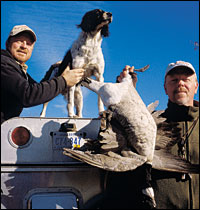 French Brittanys can be used for waterfowl hunting. "Do expect these dogs to retrieve ducks and geese in muddy cattail sloughs or in deep water lakes," says John Mooney. "But don't expect them to retrieve all day when the temperature is way below freezing, the wind is howling, and there's ice with the cold water," he adds. |
The French Brittany Gun Dog Association (Club de l'Epagneul Breton) is an established American-based organization of French Brit fanciers. The club's goal is to preserve and improve the European version of these gun dogs. The FBGDA has succeeded in having the French Brittany recognized by the United Kennel Club as a separate breed that will be included in the UKC registry system and hunt test programs.
The French Brittany Gun Dog Association also is working toward the introduction of a sanctioned field test system based on European standards and has sponsored the first "natural ability" test in the United States. The FBGDA publishes the L' Epagneul Breton magazine, which provides general background history on the breed as well as specific information on topics such as breeding standards and future hunt tests.
"When and if you're ready to buy a French Brittany, consider breeders who have gone to the European sources for their brood stock. Look for the 'French Connection' when searching for a French Brittany in the United States. Breeders in this country with dogs obtained directly from the French and European 'source' of French Brittanys probably will have the widest diversity of breeding lines. These European dogs represent the purest genetic strain of the characteristics that make the French Brittany the gun dog that it has become over 100 years," Mooney feels. "When searching for French Brittany pups or started or finished dogs, ask the sellers if they have been to France to actually see and buy their brood stock or if they have any personal relationships or direct contact with reputable and well-recognized European breeders," Mooney adds.
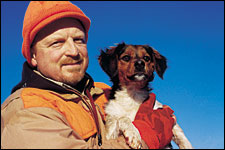 Ska, an 18-month-old French Brittany male, shown here with John Mooney, is an import directly from France. |
"When shopping for a French Brittany, try to find breeders who actually train and hunt some of their personal gun dogs. This is one very good way to get vital information on what their line of dogs will really do in the field," Mooney suggests. "And if the breeder doesn't train or hunt, ask for references to satisfied customers who do. And call those people to see how easy their pups were to train and how well they do in real-life hunting experiences.
"Inquire about guarantees on general health and genetic history. Most popular lines of French Brittanys have good health histories and few genetic flaws with a minimum of joint and eye problems. But having a specific guarantee is still a good idea," in Mooney's opinion. "Most purebred French Brittanys sell in the $800 price range, which is one big financial reason to be sure about the quality of the dog you're buying," he says.
IS A FRENCH BRITTANY A GOOD "FIRST DOG"?
"Not only is a French Brittany a good 'first dog,' it's also a good 'last dog,'" John Mooney believes. "Because these dogs are bred for their people-pleasing dispositions and their natural bird hunting instincts, a French Brit is a reasonable choice for someone just getting started with a first gun dog.
"The same thing, however, holds true for an older hunter maybe looking for a combination house dog and a bird dog that is generally easy to maintain and keep around home and to train and hunt in the field. A dog, in other words, that won't require a lot of supervision in the house and won't take a track star to keep up with it out on a hunting trip," Mooney contends. For more information on the French Brittany, contact Bruce and John Mooney at L'Escarbot Kennels in Hampton, Minnesota; (651) 480-7841 or (651) 480-7839; www.lescarbotkennels.com






